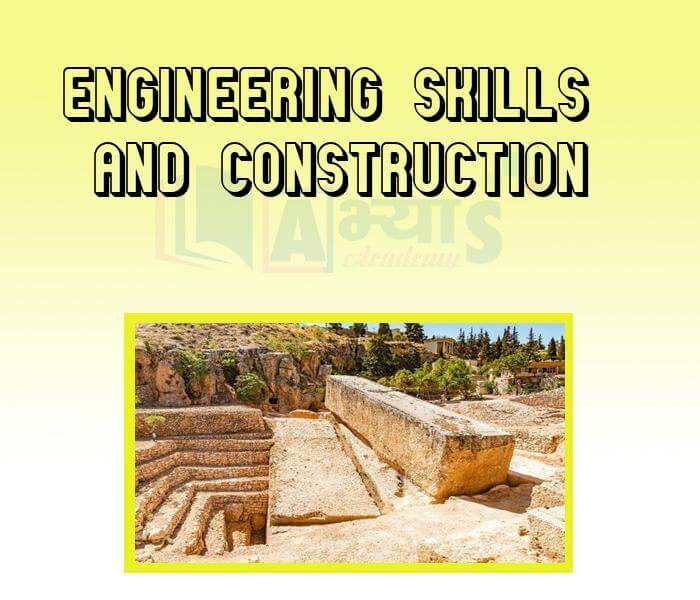Engineering skills and construction












Engineering skills and construction
Engineering Skills and Construction: Kings were expected to care for their subjects, and by making structures for their use and comfort, rulers hoped to win their praise. Construction activity was also carried out by others, including merchants. They built temples, mosques and wells.
Monuments provide an insight into the technologies used for construction. Take something like a roof for example. But the task becomes difficult if we want to make a large room with an elaborated superstructure. This requires more sophisticated skills. Between the seventh and tenth centuries architects stared adding more rooms, doors and windows to buildings. Between the eighth and thirteenth centuries the trabeate style was used in the construction of temples, mosques, tombs and in buildings attached to large stepped-wells.
Two technological and stylistic developments are noticeable from the twelfth century. The weight of the superstructure above the doors and windows was sometimes carried by arches. This architectural form was called “arcuate”. Limestone cement was increasingly used in construction. This was very high-quality cement, which, when mixed with stone chips hardened into concrete. This made construes easier and faster.
The Birth of Indo- Islamic Architecture: The coming of Muslim rulers to India saw the birth of a new style of art and architecture that came to be known as Indo-Islamic style. Indo -Islamic architecture was a blend of the local Indian style with the Islamic style. Since Islamic art itself was a composite of various influences- Turkish,Afghan,Persian and Arabi -Indo-Islamic architecture showcased a wide variety of styles.In Delhi ,Islamic influences dominated ,while in the Deccan ,local styles were more prominent in the buildings. In Bengal ,The local practice of using bricks for building continued. Indo -Islamic architecture was also influenced by the fact that the Muslim rulers often had to use Indian craftsmen,who were trained in the local styles.Building were simple,with symmetrical and beautiful lines. They now featured Islamic elements such as arches and domes.
Islam discourages the depiction of human figures in art.Therefore,much of Islamic art consist of geometric designs,Floral patterns and calligraphy.Calligraphy is the art of beautiful writing.It was developed into a fine arts by Islamic artists,who used it to copy out portions of the Quran.
Some of the earliest buildings built by the Muslims In India were their places of worships ,or mosques. These shapes were new to India. A mosque has a sihn , an open rectangular courtyard at the center,surrounded by a liwan,a pillard cloister with several entrances. A domed prayer hall stands at the western end of courtyard .at the back of the prayer hall is the Mihrab (a niche) which indicates the direction of Mecca,for faithful to face while praying . To the right of the Mihrab is the mimbar (pulpit) for the imam to conduct prayers. There is also the minar,a high slender tower ,from where the mu'azzin (priest) calls the faithfull to prayer.
Which architectural feature became increasingly prominent in construction between the eighth and thirteenth centuries? | |||
| Right Option : B | |||
| View Explanation | |||
Students / Parents Reviews [10]
Being a parent, I saw my daughter improvement in her studies by seeing a good result in all day to day compititive exam TMO, NSO, IEO etc and as well as studies. I have got a fruitful result from my daughter.

Prisha Gupta
8thOne of the best institutes to develope a child interest in studies.Provides SST and English knowledge also unlike other institutes. Teachers are co operative and friendly online tests andPPT develope practical knowledge also.

Aman Kumar Shrivastava
10thMy experience with Abhyas is very good. I have learnt many things here like vedic maths and reasoning also. Teachers here first take our doubts and then there are assignments to verify our weak points.

Shivam Rana
7thIt was a good experience with Abhyas Academy. I even faced problems in starting but slowly and steadily overcomed. Especially reasoning classes helped me a lot.

Cheshta
10thMy experience was very good with Abhyas academy. I am studying here from 6th class and I am satisfied by its results in my life. I improved a lot here ahead of school syllabus.

Ayan Ghosh
8thAbhyas is a complete education Institute. Here extreme care is taken by teacher with the help of regular exam. Extra classes also conducted by the institute, if the student is weak.

Om Umang
10thIt has a great methodology. Students here can get analysis to their test quickly.We can learn easily through PPTs and the testing methods are good. We know that where we have to practice

Barkha Arora
10thAbhyas Methodology is very good. It is based on according to student and each child manages accordingly to its properly. Methodology has improved the abilities of students to shine them in future.

Manish Kumar
10thAbout Abhyas metholodology the teachers are very nice and hardworking toward students.The Centre Head Mrs Anu Sethi is also a brilliant teacher.Abhyas has taught me how to overcome problems and has always taken my doubts and suppoeted me.

Shreya Shrivastava
8thA marvelous experience with Abhyas. I am glad to share that my ward has achieved more than enough at the Ambala ABHYAS centre. Years have passed on and more and more he has gained. May the centre flourish and develop day by day by the grace of God.
